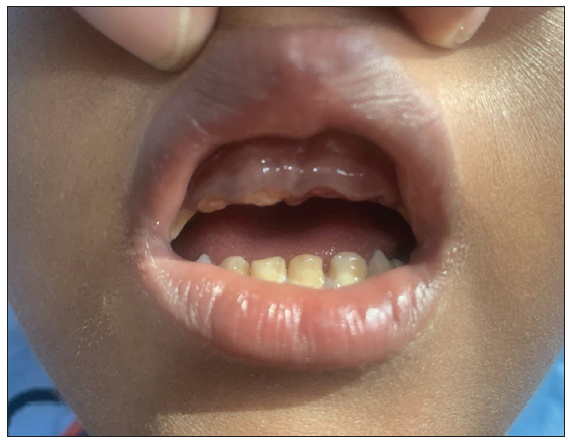Dear Editor,
A 4-year-old boy, born to third-degree consanguineous parents, presented with generalised dry, scaly, and itchy skin since birth, alongwith thinning of hair on the scalp and eyebrows. At one-month-old, he developed jaundice, high-coloured urine, pale stools, and palpable hepatomegaly. Laboratory tests revealed serum total bilirubin levels of 15.1 mg/dl (0.2–1 mg/dl), conjugated bilirubin levels of 11.5 mg/dl (0.2–0.3 mg/dl), aspartate aminotransferase (AST) of 150 IU/L (10–40 IU/L), alanine aminotransferase (ALT) of 81 IU/L (8–33 U/L), gamma-glutamyl transferase (GGT) of 81 IU/L (5–55 IU/L), alkaline phosphatase (ALP) of 597 IU/L (70–400 U/L) and serum bile acids of 78 µmol/L (<10 µmol/L). Ultrasound of the abdomen showed no significant abnormalities. Liver biopsy revealed preserved lobular architecture, mixed inflammatory infiltrates around bile ducts, mild hepatocellular cholestasis, and focal giant cells in hepatocytes. Hepato-porto-enterostomy at the age of one month improved his liver function tests (SGOT/SGPT: 64/61 IU/L, total/direct bilirubin: 2.7/1.9 g/dl from 150/81 and 15.1/11.5 g/dl). At eight months, the child developed generalised pruritus, which responded with varying doses of ursodeoxycholic acid (UDCA) and levocetirizine. After that, he continued to develop itching with partial response to levocetirizine and UDCA in varying doses. Gradually, he started developing brownish scales all over his body and was advised to use emollients. Examination revealed generalised dry brownish hyperpigmented scales [Figure 1a] along with sparsening of hair over the scalp and eyebrows [Figure 1b], hypodontia, and enamel defects [Figure 2].

Export to PPT

Export to PPT

Export to PPT
On the evaluation of liver function, total and direct bilirubin were 7 g/dl and 5.2 g/dl, respectively, SGOT and SGPT were 86 IU/L and 64 IU/L and serum albumin was 2 g/dl (3.5–5 g/dl). Repeat ultrasonography revealed chronic liver disease changes (coarse echoes with irregular texture and left lobe hypertrophy, with no obvious space-occupying lesions or intrahepatic biliary radicle dilatation (IHBRD). A diagnosis of neonatal ichthyosis-sclerosing cholangitis (NISCH) syndrome was confirmed through the next-generation sequencing which revealed a homozygous mutation in the CLDN1 gene (exon 1 variant c.191G>T, p.Cys64Phe, Depth: 182x). According to the American College of Medical Genetics recommendations, this mutation is of uncertain significance. This variant has not been reported in 1000 genomes, clinvar, and gnom AD databases, and has a minor allele frequency of 0.003% in the internal database of MedGenome Labs Ltd, Bangalore, India. In silico prediction of the variant are probably damaged by Polyphen-2 (HumDiv) and damaged by SIFT (sorting intolerant from tolerant), LRT (Likelihood Ratio Test), and MutationTaster2. Due to financial constraints, genetic testing for the parents was not done. The child was referred to the gastroenterology department for derangement of liver parameters, the dose of UDCA was hiked and the application of white soft paraffin was advised.
NISCH syndrome is a rare autosomal recessive disorder characterised by neonatal ichthyosis and sclerosing cholangitis. It is inherited as an autosomal recessive disorder. Due to the extreme rarity of the disorder, the exact prevalence is unknown; however, 21 cases have been reported in the literature until 2023. Alopecia, hypotrichosis, and ichthyosis have been reported in all cases. Dentition abnormalities, such as enamel hypoplasia and hypodontia, are seen in around 64% of patients.1 Liver involvement is heterogeneous ranging from no clinically evident disease to liver cirrhosis. Liver sonography usually appears normal, while liver biopsy reveals cholestasis, portal fibrosis, ductular proliferation, and ductular paucity.1 Our patient had a classic presentation in the form of generalised mild ichthyosis with itching, sparsening of hair, dental abnormalities, and neonatal cholangitis leading to liver cirrhosis. NISCH results from homozygous CLDN1 gene mutations which encodes for claudin-1, vital for tight junctions, which are essential for skin and liver cell connections. Various mutations have been reported in CLDN1 gene exons, including exon 1 (c.200_201delTT), the Moroccan mutation2; homozygous deletion in the nucleotide of exon 1 (p.Val66_Phe67insTer); exon 2 (c.358delG) in the Swiss population3; (c.181C>T, p.Gln61X) in a Turkish family4; and (c.578C>A, p.Tyr159Ter) in the Iranian population5 [Table 1]. The ‘Swiss’ and ‘Turkish’ mutations show a better prognosis, while the ‘Moroccan’ mutation leads to diverse phenotypes, ranging from persistent liver disease to no liver involvement, making it difficult to predict prognosis. Our patient had a novel mutation (c.191G>T, p.Cys64Phe) in exon 1, previously unreported, and experienced persistent ichthyosis and progressive liver disease, resulting in cirrhosis by the age of four. The differential diagnosis includes other inherited disorders associated with liver involvement and ichthyosis [Table 2]. The prognosis of NISCH remains unclear due to the limited number of published reports. Some genetic variants associated with NISCH have exhibited varying degrees of extracutaneous involvement, including liver abnormalities. However, more studies are needed to better understand the prognosis and broader implications of this condition.
Table 1: Various mutations and clinical phenotypes
Type of mutation variant based on geographic location Gene Location Variant Prognosis Moroccan2 CLDN1 Exon 1 (c.200_201delTT) Variable; persistent liver disease to no liver involvement Swiss3 CLDN1 Exon 1 (p.Val66_Phe67insTer) Regression of cholestasis CLDN1 Exon 2 (c.358delG) Regression of cholestasis Turkish4 CLDN1 Exon 1 (c.181C>T, p.Gln61X)Neonatal jaundice recovering by 6–12 months
Ichthyosis and hypotrichosis persisting
Iranian5 CLDN1 Exon 1 (c.578C>A, p.Tyr159Ter) Follow-up findings not available Indian6 CLDN1 Exon 1 (p.Tyr47Ter) Cholestasis resolved in infancy Current report CLDN1 Exon 1 (c.191G>T, p.Cys64Phe) Progressing to chronic liver diseaseTable 2: Disorders with ichthyosis and neonatal cholestasis
Disorder Mutation Clinical features MEDNIK Syndrome AP1S1 geneMental retardation, enteropathy, deafness, peripheral neuropathy, ichthyosis, keratoderma
Neonatal cholestasis
ARC Syndrome VPS33B or VIPAR geneArthrogryposis, renal dysfunction, cholestasis
Severe developmental delay
Zellweger Spectrum Disorders PEX geneIchthyosis, liver dysfunction, hypotonia
Neurological impairment
Type 2 Gaucher’s Disease GBA gene Neonatal cholestasis, hepatosplenomegaly, ichthyosis, neurological declineIn conclusion, we would like to highlight that genetic testing is essential for accurate diagnosis and that the specific CLDN1 gene mutation can influence the severity of liver disease. Understanding the genetic basis of NISCH can help predict disease progression and guide appropriate interventions in affected individuals.
留言 (0)